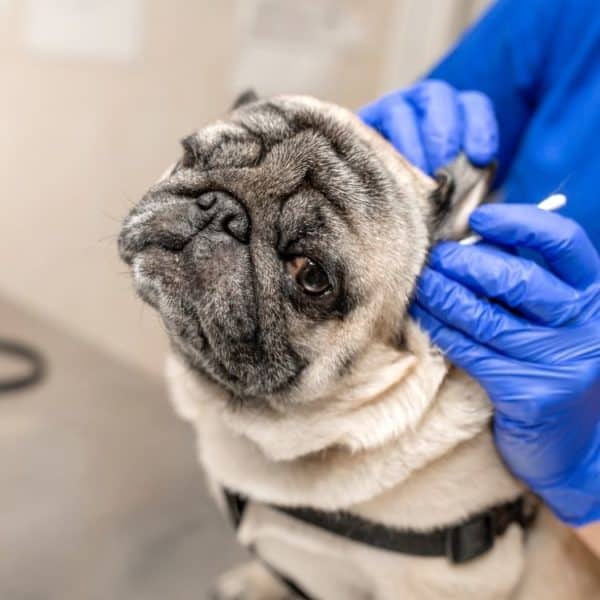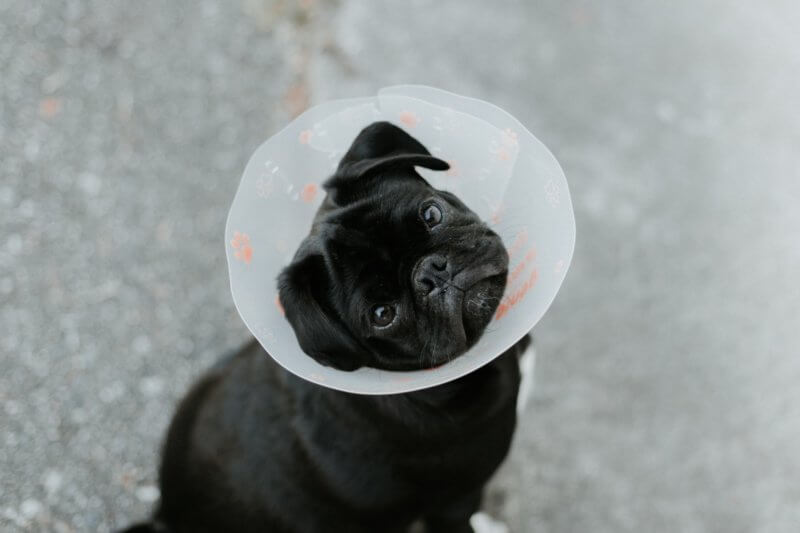Pugs are among the most popular dog breeds due to their squished faces, adorable wrinkles, and bulging eyes. They have a pleasant personality that can be described as affectionate, charming, loyal, and mischievous. A pug’s humor is more on the dry side, with a serious, laid-back attitude. Due to these qualities, many people consider getting a pug, but after a quick research they end up asking themselves: why are pugs so expensive?
Those expecting the pug to be the perfect toy breed should think twice before adopting this otherwise amazing and lovely dog into their family.
What you need to know first is that pugs can be quite stubborn, they will become obese if they do not get enough exercise. Their prominent eyes can get easily injured unless you take care to keep them moist.
Get some proper grooming scissors to keep their dense coat shed and to keep their facial wrinkles clean.
But most of all it is important to mention, once again, that pugs can cost you a lot.
First of all, well-bred puppies are expensive and their maintenance over the years can also have an impact on your finances.
Before making a pug the new beloved member of your family, here are the costs you need to be aware of:
Pug’s initial price
Pug prices vary from $500 to $1500 and can reach up to $6000 if they are of show quality and have breeding rights.
So, if you want your dog to come from an excellent line, you will have to pay more depending on the pedigree.
The price also depends on multiple factors such as dog age, the place where you buy it from, and the color of the fur.
Why are pugs so expensive you asked?

Well, we need to start by saying that the main reason why the pug’s purchasing price is so high is its breeding challenges.
Pugs are prone to pregnancy complications and many breeders have to opt for expensive Caesarean sections instead of natural birth because of the females’ narrow birth canals.
The average litter size for a pug is 3 puppies, which means that medical expenses per puppy are higher compared to larger breeds that have a litter size of 8 to 10 puppies.
There is also the possibility of adopting a pug who badly needs a loving home, and costs will be lower if you choose this option – $350 to $550 to cover registrations and vaccinations.
Older dogs are less expensive, but many people want a pup because they are generally healthier, have a longer life expectancy, and they don’t risk bringing at home a dog that has baggage from previous owners.
The pug’s bare necessities
Food is the main ongoing cost with all dogs, and dog food is not an expense you can spare when it comes to your pug.
Even if this breed is small and should not be overfed, pugs have a tendency of becoming obese and good quality food is required to keep your canine companion healthy and reduce vet bills to a minimum.
Average food costs per month range between $20 and $30, to which you should add the occasional treats.
Flea treatments and tick collars are also a must as these pests canmake your dog very uncomfortable and cause several diseases – their costs rise to $250 a year.
One-time expenses
Aside from water and food bowls that cost around $20, there are other useful items you will need to buy for your pug, once or multiple times, depending on how long they last: a collar ($20) and a leash ($20), a dog bed ($30), a kennel for training and transportation ($50), a brush ($10), toys (costs vary) and a jacket if you live in a cold climate ($50).
When you need help with your dog

Welcoming an adorable pug into your family will make your days funnier, but at the same time you should keep in mind that having a dog is a major responsibility.
Your furry friend has multiple needs you need to meet, from supervising it to making sure it receives good training.
You may not always have the time and knowledge to constantly look after your pug and teach it how to cooperate with you.
As a result, it is possible to get some extra dollars out of your pocket for the following services: dog training ($30 to $50 per class), dog walking ($0.50 to $1 per minute) and dog sitting ($20 to $30 per day).
In case you need to travel and cannot take your canine companion with you, boarding a dog can cost anywhere from $25 to $85 per night.
Vet bills
This part of your pug-related expenses really has the potential to skyrocket, as pugs are renowned for their health issues. [1]
So, if you really want to know why are pugs so expensive, you will find out in the following lines

Let’s start with the minimum, though. A common one-time expense is spaying or neutering, which varies between $180 and $240.
Even if your pug is healthy, you will still have to ensure 3 or 4 regular visits to the vet for preventative care, vaccination, heartworm, and potentially blood works – approximately $50 for a standard examination.
For pug owners, the American Humane Society estimates vet bills of about $1000 per year for a generally healthy dog, but if, unfortunately, your pug has health issues, you may have to spend variable and high amounts of money to treat conditions such as:
-
Skin conditions
Skin conditions in pugs occur because of the folds in their skin, which create the perfect environment for fungi and bacteria to develop.
You will have to clean your pug’s wrinkles regularly and fix skin conditions as soon as possible. The most common skin conditions in pugs are ringworm, allergies, demodectic mange, and skin cancer.
-
Breathing issues
The pug’s elongated palates can cause breathing difficulties when the dog is very excited or exposed to hot weather for a long period of time.
Signs that your pug has trouble breathing are panting, wheezing, snoring, and snorting – these are very common in brachycephalic breeds.
-
Eye problems
Their prominent eyes makes pugs more susceptible to issues such as accidental injury, dry eye, cherry eye, corneal ulcers, and cataracts.
Check your pug’s eyes regularly for symptoms such as red or watery eyes, squinting, rubbing eyes frequently, or having visible injuries.
-
Tail problems
Having that adorable curly tail that everyone loves can also cause issues such as screw tail (a malformation of one or multiple vertebrae in the tail) or limp tail (the tail is straight or down which can be an indication that the tail is fractured).
-
Pug encephalitis
Pugs between two and three years of age can suffer from encephalitis, a condition where brain tissue becomes inflamed and may lead to other problems such as tumors or epilepsy.
-
Digestive problems
Digestive problems in pugs can be caused by eating foreign objects, allergies, parasites, and bacteria; some male pugs are prone to intussusception, a condition where the small or large intestine slides into itself.
-
Spine problems
Spine problems that pugs are prone to are herniated discs and hemivertebrae, conditions that can be detected by taking an X-ray of the dog’s spine.
There are also other ortho problems that could affect your pooch, such as luxating patellas and joint problems.
When these conditions are severe enough, the dog may require surgery such as intervention to realign the kneecap and prevent it from popping out of place, which can cost thousands of dollars.
-
Dental disease

Dental diseases are very common in domesticated canines, even at a very young age, and brachycephalic breeds often deal with more teeth problems. These issues should never be ignored. They can cause other conditions that are even more expensive to treat (not to mention the pet’s suffering). We talk about tooth loss, joint issues, and kidney, heart, and liver problems.
-
Diabetes
Diabetes affects one in 500 dogs, but pugs are more likely to get this disease. There are two types of diabetes that can affect dogs: insulin deficiency diabetes and insulin resistance diabetes.
Your pug’s vet should be able to determine the type of diabetes your dog has and provide a proper treatment plan to ensure a happy healthy live in spite of the condition.
-
Hair loss
Hair loss or alopecia in pugs is similar to male balding in humans, who gradually lose hair without new hair strands growing back. Pugs may deal with bald spots on various parts of their body, such as chest, belly, throat, and inside their legs. It’s good idea to try natural remedies for shedding if situation is not that bad.
These bald spots do not affect their wellbeing unless they become too dry and cause the dog to scratch excessively.
Owning this particular dog breed can cost you more than you think. We recommend to get good pet insurance to save money in case your pug requires expensive treatments at some point.
The average dog insurance policy premium was around $50 per dog in 2019. The best time to get one is as soon as possible.
The lowest premiums apply when your dog is the healthiest. Most companies do not cover pre-existing conditions and will most likely not offer general medical coverage for senior pugs.
Some pug owners hope they will be lucky enough to own a healthy dog, but a study from 2013 suggests you should expect significant vet bills if you are a pug owner. 688 of the 1009 pugs included in the study had at least one health issue.[3]
So, preparing for the worst when you own a pug is a good idea, as measures such as taking good care of your pet’s wellbeing, having regular checkups, and getting pet insurance can significantly lower your vet bills on the long term.
We are talking about a 12-15 years lifespan in which you will be able to enjoy the company of these loyal and charming dogs. It will also be a period when you will have to cover certain expenses to ensure the dog’s wellbeing and comfort.
Bottom Line
It is important to know the types of problems that pugs can have, as well as the general expenses that come with owning a dog. Your pug won’t have to deal with any of those issues.
Getting a pug is a major decision. You should think carefully whether you are able or not to ensure a normal healthy lifespan for your dog. Your furry friend will be grateful for that.
Having access to the right information is vital. You can find out why are pugs so expensive and reduce those costs by preventing a variety of health conditions that you dog can develop.

